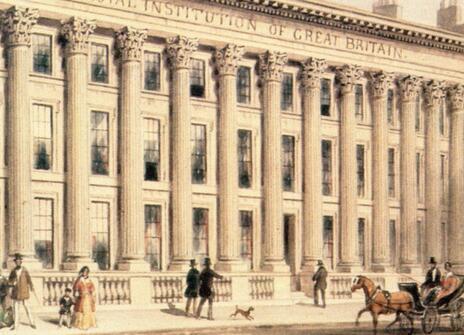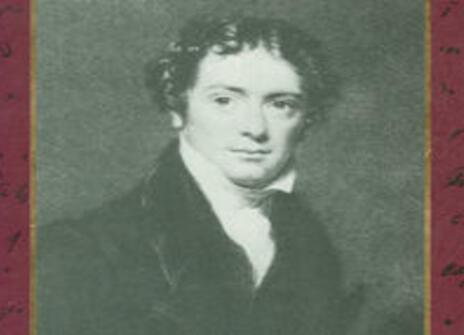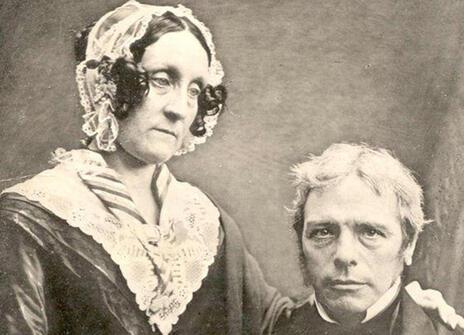Biography
Ri positions
- Laboratory Assistant, 1813,1815-1826
- Director of the Laboratory, 1825-1867
- Fullerian Professor of Chemistry, 1833-1867
- Superintendent of the House, 1852-1867
(Acting 1821–1826)
(Assistant 1826–1852)
Michael Faraday was born in Newington Butts, Southwark, the son of a Sandemanian blacksmith who had moved from the North West of England.
He served an apprenticeship with George Riebau as a bookbinder from 1805 to 1812. He was Assistant in the Royal Institution’s laboratory for part of 1813 and again from 1815 to 1826 (touring the Continent with Humphry Davy (qv) in the interim). He was appointed Assistant Superintendent of the House of the Royal Institution in 1821, Director of the Laboratory in 1825 and six years later the Fullerian Professorship of Chemistry was created for him. In the mid 1820s he founded both the Friday Evening Discourses and the CHRISTMAS LECTURES and delivered many lectures in both series himself. He was appointed Scientific Adviser to the Admiralty in 1829, was Professor of Chemistry at the Royal Military Academy, Woolwich between 1830 and 1851 and Scientific Adviser to Trinity House from 1836 to 1865.
His major discoveries include electro–magnetic rotations (1821), benzene (1825), electro-magnetic induction (1831), the laws of electrolysis and coining words such as electrode, cathode, ion (early 1830s) the magneto-optical effect and diamagnetism (both 1845) and thereafter formulating the field theory of electro-magnetism.
He was twice offered the Presidency of the Royal Society, but declined on both occasions. He publicly stated several times that he would not accept a knighthood, but no evidence has been found that he was ever offered one. He was, however, awarded a Civil List Pension in 1836 and in 1858 the Queen provided him with a Grace and Favour House at Hampton Court where he died.
Source: Oxford Dictionary of National Biography
Faraday's papers
The papers include laboratory notebooks, lecture notes and various publications, some administrative papers on the Royal Institution of Great Britain including cash books, correspondence regarding his work for the Admiralty and the Corporation of Trinity House whilst, general communication with people and other organisations. Other items include his book collection, scrapbooks, portfolio of portraits and apparatus.
Catalogue information is currently available on the National Archive's Discovery service and a summary of the collection can be found on the AIM25 website.
Other resources
A complete edition of Faraday's approximately 4900 extant letters is being published under the editorship of Frank James at the Royal Institution.
Publications
Books
Faraday published only one book, Chemical Manipulation, Being Instructions to Students in Chemistry (1827). His other publications are collections of papers or lecture notes; his famous Chemical History of a Candle (1861) was edited and published by his friend William Crookes.
The other titles are collections of papers and lecture notes, some published after his death:
- Chemical Manipulation, Being Instructions to Students in Chemistry (1827)
- Experimental Researches in Electricity, Vol I, II & III (1837, 1844, 1855)
- Experimental Researches in Chemistry and Physics (1859)
- W. Crookes. ed. A Course of six lectures on the Various Forces of Matter (1860)
- W. Crookes. ed. A Course of six lectures on the Chemical History of a Candle (1861)
- W. Crookes. ed. On the Various Forces in Nature. (1873)
- The liquefaction of gases (1896)
Manuscripts which have been published
- Brian Bowers and Lenore Symons, ‘Curiosity Perfectly Satisfyed’: Faraday’s travels in Europe 1813‐1815, (London, 1991). Based on his papers held at the Institution of Engineering and Technology.
- Frank A.J.L. James, The Correspondence of Michael Faraday, (London, 1991‐2008). The complete correspondence of Michael Faraday consists of six volumes.
- Frank A.J.L. James, Guide to the Microfilm edition of the Manuscripts of Michael Faraday (1791‐1867) from the Collections of the Royal Institution, The Institution of Electrical Engineers, The Guildhall Library [and] The Royal Society, (2nd ed., Wakefield, 2001). The vast majority of Faraday’s manuscripts, apart from letters, published on microfilm and cd.
- Thomas Martin, Faraday’s Diary, 7 volumes and index, (London, 1932–36). A typescript edition of Faraday’s experimental notebooks with diagrams.





